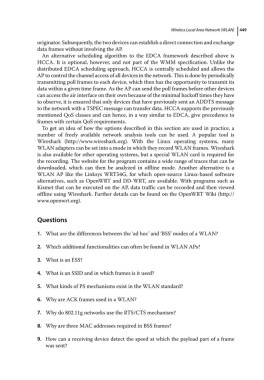Page 463 - From GMS to LTE
P. 463
Wireless Local Area Network (WLAN) 449
originator. Subsequently, the two devices can establish a direct connection and exchange
data frames without involving the AP.
An alternative scheduling algorithm to the EDCA framework described above is
HCCA. It is optional, however, and not part of the WMM specification. Unlike the
distributed EDCA scheduling approach, HCCA is centrally scheduled and allows the
AP to control the channel access of all devices in the network. This is done by periodically
transmitting poll frames to each device, which then has the opportunity to transmit its
data within a given time frame. As the AP can send the poll frames before other devices
can access the air interface on their own because of the minimal backoff times they have
to observe, it is ensured that only devices that have previously sent an ADDTS message
to the network with a TSPEC message can transfer data. HCCA supports the previously
mentioned QoS classes and can hence, in a way similar to EDCA, give precedence to
frames with certain QoS requirements.
To get an idea of how the options described in this section are used in practice, a
number of freely available network analysis tools can be used. A popular tool is
Wireshark (http://www.wireshark.org). With the Linux operating systems, many
WLAN adapters can be set into a mode in which they record WLAN frames. Wireshark
is also available for other operating systems, but a special WLAN card is required for
the recording. The website for the program contains a wide range of traces that can be
downloaded, which can then be analyzed in offline mode. Another alternative is a
WLAN AP like the Linksys WRT54G, for which open‐source Linux‐based software
alternatives, such as OpenWRT and DD‐WRT, are available. With programs such as
Kismet that can be executed on the AP, data traffic can be recorded and then viewed
offline using Wireshark. Further details can be found on the OpenWRT Wiki (http://
www.openwrt.org).
Questions
1. What are the differences between the ‘ad hoc’ and ‘BSS’ modes of a WLAN?
2. Which additional functionalities can often be found in WLAN APs?
3. What is an ESS?
4. What is an SSID and in which frames is it used?
5. What kinds of PS mechanisms exist in the WLAN standard?
6. Why are ACK frames used in a WLAN?
7. Why do 802.11g networks use the RTS/CTS mechanism?
8. Why are three MAC addresses required in BSS frames?
9. How can a receiving device detect the speed at which the payload part of a frame
was sent?

